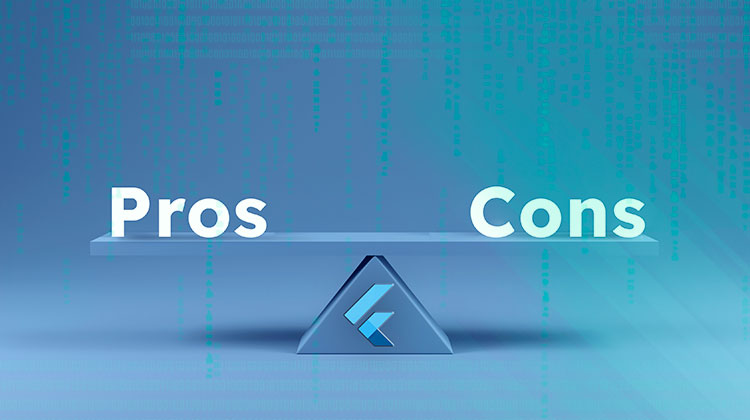Pros and Cons of Flutter App Development: Is It the Right Choice for Your Next Project?

Flutter app development quickly matured and became popular across industries despite being a rather new framework (launched in 2017). In fact, its use has grown exponentially between 2019-2022, and it climbed to the top ten of most used cross-platform mobile frameworks in 2023.
Flutter has reached these heights and surpassed React Native thanks to various factors, with versatility and user-friendliness positioned at the forefront. You may not even know that some of the best apps, such as eBay Motors, exist thanks to Flutter.
But it has become one of the most coveted SDKs for a reason. This also contributed to many bright minds dreaming of becoming a Flutter developer.
In this article, we’ll analyze the pros and cons of Flutter and help you decide whether to use it for your upcoming project.
What is Flutter App Development?
Flutter app development is Google’s open-source UI toolkit that makes it possible for devs to create natively compiled applications with the Dart language. These have a single codebase and can be mobile, web, and desktop.
Pros and Cons of Flutter App Development
Get ready to explore the pros and cons of Flutter app development and how these can dictate your Flutter experience.
Flutter App Development Benefits
1. Cross-platform Development
Whether you want to do it yourself or hire a Flutter developer, creating and maintaining separate codebases for each platform is a hassle you should avoid at all costs.
Taking the Flutter app development route is a trick to avoid fretting over this issue, as you won’t have to write separate codes.
This SDK has another great, related benefit. – Flutter comes with diverse pre-designed widgets, meaning you can bulletproof your app with a consistent look and feel across devices. If you hope to create remarkable user experience, this is non-negotiable.
2. Fast Development and Hot Reload
You might already know that having to restart the app to see whether code changes had any effect can drag your project and cause stress you could have avoided. Well, not with Hot Reload.
As a shortcut to quick experimentation, bug fixing, and UI tweaking, Hot Reload mimics an instant feedback loop. These are vital characteristics for an accelerated development cycle.
Plus, Flutter eliminates slow and cumbersome processes because it has an extensive library of customizable components and allows devs to build complex interfaces quickly.
3. Rich and Customizable User Interface
Whether an app is visually appealing and unique contributes largely to user experience. The best you can do is stay away from traditional frameworks that tend to rely way too much on platform-specific UI components and cause inconsistent cross-platform designs.
Flutter’s perks include a highly customizable and aesthetic UI, which helps you tap into another advantage: control over every pixel on the screen and fine-grained customization.
4. High Performance
With Flutter app development, you can compile directly to native ARM code and bypass ever needing a JavaScript bridge. How does that give you leverage? You’ll execute everything faster and create smoother animations, which will help set the foundations for a responsive user experience.
Plus, you’ll encounter less lag as your apps will run equally well on iOS and Android. The high performance you get as a result also allows you to implement vibrant and interactive features without compromising speed. Thanks to this, you can develop complex animations and transitions that render uninterruptedly.
5. Lower Development Costs
As mentioned before, Flutter app development enables devs to write a single codebase and deploy it on multiple platforms. This benefit prevents overspending, as you don’t need different platforms and multiple teams.
Being one of the fastest performing SDKS with efficient memory management, Flutter translates into less demanding maintenance costs. After all, it doesn’t require extensive optimization and debugging efforts, which is often the case with other frameworks.
6. Mild Learning Curve
Flutter is simple and developer-friendly. Its effective structure includes a declarative UI programming model and reactive framework, which makes UI changes more straightforward.
Flutter app development is also the only area where not being bilingual is a positive. Since it uses a single language (Dart), you don’t have to worry about whether your skillset includes multiple languages or frameworks. As a result, new team members can also enjoy faster onboarding, translating into lower training costs.
7. Engaged Community and Vast Documentation
Devs can find invaluable resources when learning or solving an issue because Flutter’s community actively contributes to forums, GitHub repositories, and online tutorials. Getting-started guides and advanced topics are all a part of Flutter app development’s extensive documentation.
8. Reliable Support
There are various perks of being Google’s child, but regular updates, new features, and bug fixes must be the first choice. Flutter is never behind the latest tech breakthroughs, meaning your app will have much-needed stability and longevity.
9. Cross-Platform Adaptability and Localization
Flutter is among the best solutions if you target a global audience and want to translate apps for different languages, regions, and devices.
Flutter App Development Drawbacks
1. Larger App Sizes
Keep in mind that Flutter apps might have a runtime containing the framework and necessary libraries, which increases their file size. This can pose a problem for users with limited storage space or slower internet connections and cause longer download times and higher data usage.
2. Challenges with Native Functionality
While Flutter provides plugins for common native features, expect that some functionalities may require custom platform-specific code integration. You could encounter limitations or need slightly demanding workarounds if your project relies on complex native features.
3. Not the Best Option for Highly Complex Apps
Flutter app development sometimes runs into problems when dealing with platform-specific features or integrating deeply with native APIs. As a result, the process of implementing some advanced features or optimizations could be tricky.
4. Stability Risks Due to Ongoing Development
Flutter may not be the newest, but it’s still a relatively young SDK. Updates may impose new bugs or breaking changes and affect your project’s stability.
5. Limited Ecosystem
Because Flutter is relatively new, it has a more limited ecosystem. This means fewer third-party libraries, plugins, and community resources are available.
6. Learning Dart Language
Dart is easy to nail for devs well-versed in object-oriented languages, such as Java or JavaScript. However, it may be trickier for others. In some cases, this could slow down initial development as devs become proficient in Dart.
How to Choose the Best IDE for Flutter Development
A positive Flutter experience may also depend on choosing the best IDE for Flutter app development.
What are Popular Flutter IDEs?
Android Studio, Visual Studio Code (VS Code), and IntelliJ IDEA are the most optimal choices for Flutter.
IDE Features and Perks
- Android Studio: This IDE allows a smooth integration with Flutter and provides built-in widgets, templates, and debugging tools.
- Visual Studio Code (VS Code): A lightweight and customizable development experience that provides Flutter and Dart support extensions.
- IntelliJ IDEA: It includes advanced features like intelligent code completion, refactoring, and version control integration, making it ideal for complex projects.
Why You Must Consider Developer Needs When Choosing Flutter IDE
Every dev has a unique workflow and matching preferences. Naturally, the IDE they choose should match those requirements.
As a result, you should consider:
- IDE features
- Performance
- Customization options
- Your familiarity with the tool
Choose an IDE that creates the right conditions for your productivity to grow and cultivates a smooth development process that makes a high-quality Flutter experience more likely.
How to Ensure the Best Flutter Experience for Your Business
Take the following steps to ensure optimal outcomes.
1. Weight Out Whether It’s Good for Your Project
Before starting, consider what kind of app you’re building – small, large, complex, mobile, web, etc. Or, perhaps, you’d like to migrate your existing app to Flutter. Other factors to consider are your system parameters, desired features, and whether you want a cross-platform app.
These insights will help you determine your budget, timeline, and project specifics necessary to start on a good note.
2. Choose the Right Flutter Developer
Find and hire a Flutter developer with the means, knowledge, and experience to deliver an app matching your vision and resources.
3. Seek Testimonials and Feedback
Check the testimonials, reviews, and other relevant info to gauge whether to collaborate with the Flutter team or developer you found them online or someone recommended.
Conclusion
Flutter app development is the best path toward building cross-platform apps that allow stunning animations, smooth rendering, and an overall exceptional UI. Contact us if you strive to differentiate your business with technically flawless and visually eye-popping apps.

